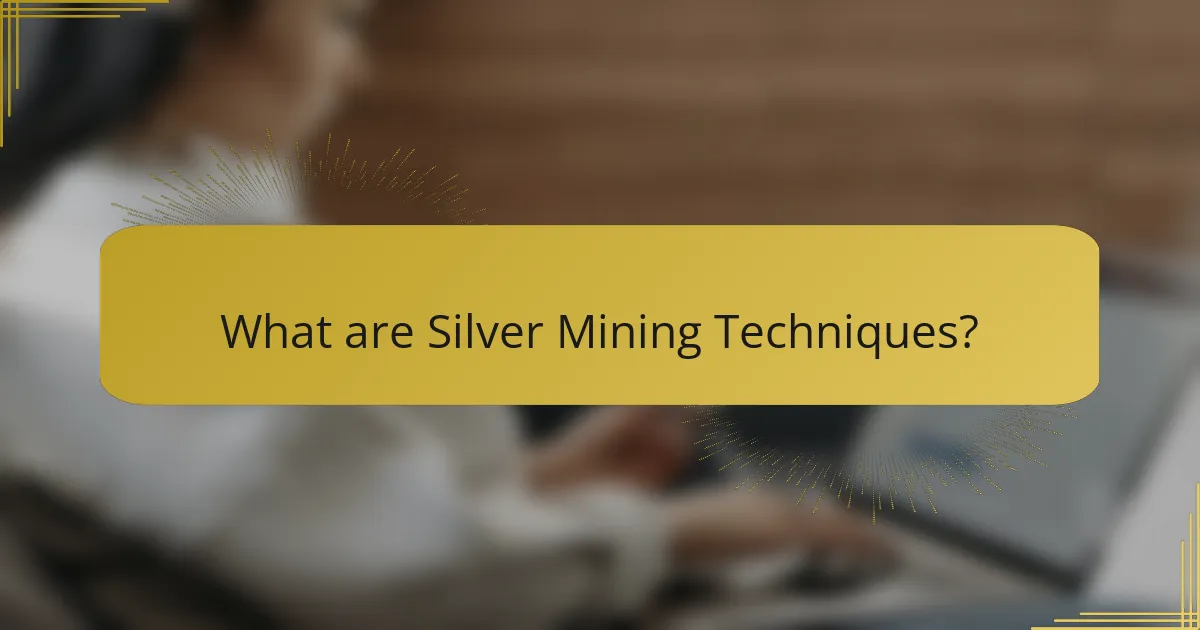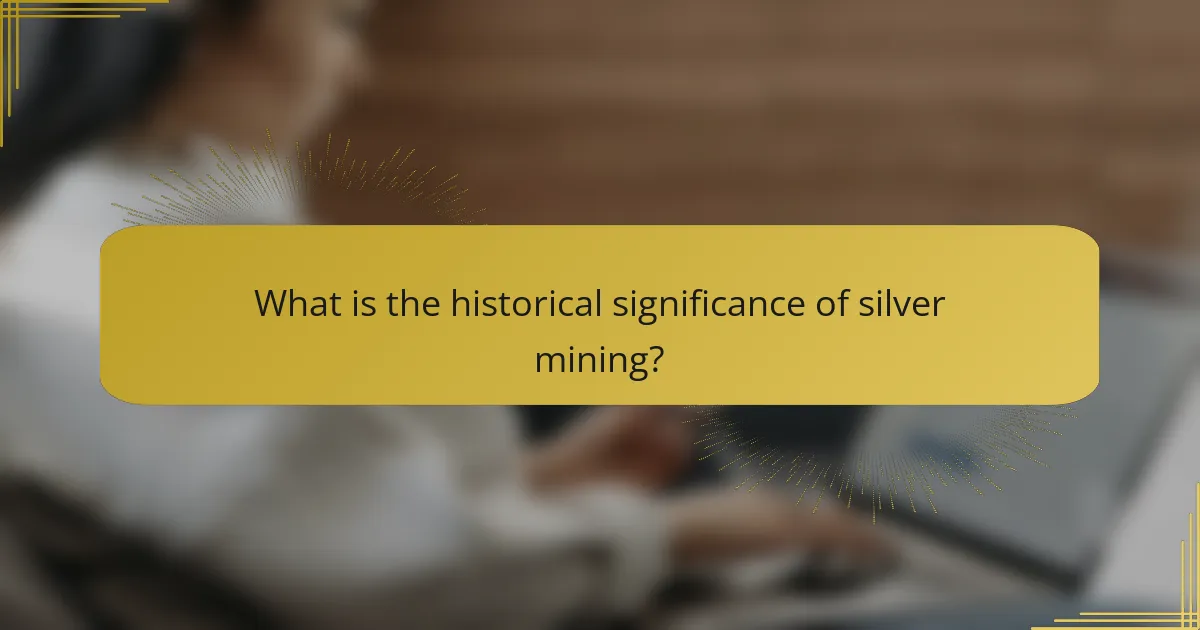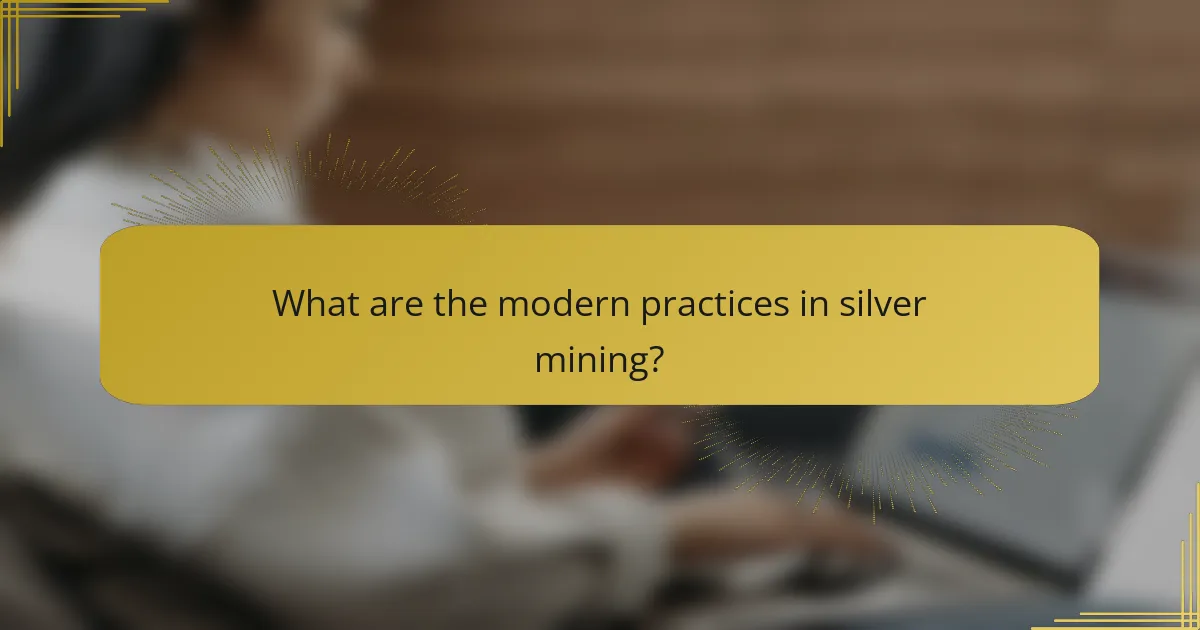Silver mining techniques encompass various methods employed to extract silver from the earth, including traditional mining, heap leaching, and underground mining. These techniques have evolved significantly over time, reflecting technological advancements and changes in economic practices. Historically, silver mining has influenced economies and societies, driving exploration and trade, particularly during the Spanish conquest of the Americas. Modern practices focus on advanced extraction methods and sustainability measures, emphasizing environmental stewardship and regulatory compliance. This article provides a comprehensive overview of the evolution of silver mining techniques and their historical significance.

What are Silver Mining Techniques?
Silver mining techniques include various methods used to extract silver from the earth. These methods have evolved over time and include traditional mining, heap leaching, and underground mining. Traditional mining involves extracting silver ore from the ground using manual labor and basic tools. Heap leaching is a more modern technique that involves piling ore and applying chemicals to extract silver. Underground mining is used when silver deposits are located deep beneath the surface. Each technique has its own advantages and disadvantages based on the location and depth of the silver ore. Historically, techniques have progressed from simple hand tools to advanced machinery, reflecting technological advancements in mining.
How have silver mining techniques evolved over time?
Silver mining techniques have evolved significantly from ancient times to the present. Initially, silver was extracted using simple methods like panning and manual digging. In the Middle Ages, miners began to use more advanced techniques, such as the use of fire and water to separate silver from ore. The introduction of the mercury amalgamation process in the 16th century revolutionized silver extraction, increasing efficiency.
By the 19th century, the advent of steam power enabled deeper mining operations and the use of machinery. Techniques like cyanidation emerged in the late 19th century, allowing for the extraction of silver from low-grade ores. Today, modern mining employs advanced technologies, including automated machinery and digital monitoring systems. These innovations have improved safety, efficiency, and environmental sustainability in silver mining.
What historical factors influenced the development of silver mining techniques?
The development of silver mining techniques was influenced by several historical factors. The discovery of silver deposits in regions such as the Americas led to increased mining activity. Spanish colonization in the 16th century significantly advanced mining methods. Innovations such as the patio process for extracting silver from ore emerged during this time. The demand for silver in Europe fueled investment in mining technologies. Industrialization in the 19th century introduced machinery that enhanced extraction efficiency. Additionally, advancements in chemistry improved ore processing techniques. The establishment of mining laws and regulations also shaped operational practices. These factors collectively contributed to the evolution of silver mining techniques over time.
How did technological advancements impact silver mining methods?
Technological advancements significantly transformed silver mining methods. Innovations such as mechanized drills improved the efficiency of ore extraction. The introduction of steam power allowed for deeper mining operations. Additionally, advancements in metallurgy enhanced the processing of silver ore. For instance, the use of cyanidation increased silver recovery rates. Improved transportation methods facilitated the movement of mined silver. These changes collectively reduced labor costs and increased production output. Historical data shows that these advancements led to a surge in silver production during the 19th century.
What are the primary techniques used in silver mining?
The primary techniques used in silver mining include underground mining, open-pit mining, and heap leaching. Underground mining involves extracting silver ore from deep within the earth. This method is often used when silver deposits are located in hard-to-reach areas. Open-pit mining is employed when silver deposits are close to the surface. This technique removes large amounts of soil and rock to access the ore. Heap leaching is a process that involves stacking ore in piles and applying a leaching solution to extract silver. Each technique has its own advantages and is chosen based on the specific characteristics of the silver deposit. Historical data shows that these methods have evolved over time to improve efficiency and reduce environmental impact.
What is the process of underground silver mining?
Underground silver mining involves several key steps. First, miners identify silver deposits through geological surveys. Next, they create access points, typically through shafts or declines. Once access is established, miners excavate the ore using drilling and blasting techniques. The mined ore is then transported to the surface for processing. At the surface, the ore undergoes crushing and milling to extract silver. Finally, the extracted silver is refined to achieve purity. This process has evolved over time, with advancements in technology improving efficiency and safety.
How does open-pit mining differ from underground mining for silver?
Open-pit mining and underground mining are two distinct methods for extracting silver. Open-pit mining involves removing large amounts of soil and rock to access silver deposits near the surface. This method is typically more cost-effective and allows for the extraction of larger quantities of ore. It also requires less labor compared to underground mining.
In contrast, underground mining involves creating tunnels or shafts to reach deeper silver deposits. This method is more labor-intensive and generally more expensive due to the need for specialized equipment and safety measures. Underground mining is often used when silver deposits are located at significant depths where open-pit mining is not feasible.
The choice between these methods often depends on the depth of the silver deposits and economic considerations. According to the U.S. Geological Survey, open-pit mining can yield higher production rates, while underground mining may provide access to richer ore bodies.

What is the historical significance of silver mining?
Silver mining has played a crucial role in shaping economies and societies throughout history. The discovery of silver deposits often led to economic booms, attracting settlers and investors. For instance, the Spanish conquest of the Americas was driven by the search for silver, particularly in regions like Potosí, Bolivia. This mining led to vast wealth for Spain and fueled European economies in the 16th and 17th centuries.
Additionally, silver mining contributed to the development of trade routes and international commerce. The global demand for silver influenced trade patterns, linking Europe, Asia, and the Americas. Silver was used as currency, facilitating trade and commerce across continents.
Moreover, silver mining had significant social impacts. It led to the establishment of mining towns and communities, shaping demographic patterns. The labor force often included indigenous peoples and enslaved Africans, highlighting issues of exploitation and social inequality.
Overall, the historical significance of silver mining is evident in its economic, social, and cultural impacts, influencing global history and development.
How did silver mining shape economies in historical contexts?
Silver mining significantly influenced economies throughout history. It provided a crucial source of wealth and trade for many nations. In the 16th century, Spanish colonies in the Americas became wealthy from silver mining. The Potosí mine in Bolivia produced vast amounts of silver, boosting Spain’s economy. This influx of silver led to increased trade with Europe and Asia. The wealth generated also financed wars and colonial expansion. In Mexico, silver mining stimulated local economies and created jobs. Silver became a global currency, facilitating international trade. Thus, silver mining played a vital role in shaping historical economic landscapes.
What role did silver mining play in trade and commerce?
Silver mining played a crucial role in trade and commerce by providing a valuable currency and facilitating economic growth. The extraction of silver increased the availability of money, which stimulated trade between regions. In the 16th century, silver from the Americas significantly impacted European economies. It enabled the expansion of global trade networks, connecting Europe, Asia, and the Americas. The influx of silver led to inflation in Spain, affecting its economy and trade dynamics. Additionally, silver was used in international transactions, enhancing trade relationships. Overall, silver mining was integral to the development of commerce and the establishment of monetary systems.
How did silver mining influence social structures in mining communities?
Silver mining significantly influenced social structures in mining communities by creating economic opportunities and social hierarchies. The influx of wealth from silver led to the establishment of diverse job roles, including miners, merchants, and service providers. This economic boom attracted a large population, resulting in a rapid growth of towns and communities.
Social stratification emerged, with wealthy mine owners and investors at the top. Laborers often faced harsh working conditions, leading to class divisions. Community organizations, such as labor unions, formed in response to these conditions, advocating for miners’ rights.
Historical records indicate that mining towns often had distinct social dynamics, with cultural diversity from immigrant workers. This diversity enriched local culture but also sometimes led to tensions among different groups. Overall, silver mining reshaped social structures by intertwining economic prosperity with social complexity.
What are the environmental impacts of historical silver mining techniques?
Historical silver mining techniques have significant environmental impacts. These techniques often involved extensive land disturbance and deforestation. The removal of vegetation led to soil erosion and habitat destruction. Water pollution was a major concern due to the use of toxic chemicals like mercury and cyanide. These pollutants contaminated local water sources, affecting aquatic life and human health. Heavy metal runoff from mining sites also contributed to soil degradation. The legacy of these practices continues to affect ecosystems today. Historical records indicate that many mining areas remain contaminated long after operations ceased.
How did early silver mining techniques affect local ecosystems?
Early silver mining techniques significantly disrupted local ecosystems. These methods often involved extensive deforestation to access mineral deposits. The removal of trees led to soil erosion and loss of habitat for wildlife. Additionally, the use of mercury in processing silver caused toxic contamination of water sources. This mercury pollution harmed aquatic life and affected human health in nearby communities. The introduction of heavy machinery further altered landscapes, compacting soil and disrupting natural water flow. Overall, early silver mining practices had detrimental effects on biodiversity and ecosystem stability.
What measures were taken historically to mitigate environmental damage?
Historically, various measures were taken to mitigate environmental damage from silver mining. Early mining operations implemented techniques like reforesting areas after mining activities ceased. Regulations were established to control water pollution from mining runoff. The use of mercury was limited to reduce toxic contamination in nearby water sources. Additionally, miners adopted practices to reduce soil erosion and protect local wildlife habitats. In the 20th century, stricter environmental laws emerged, promoting sustainable mining practices. For example, the U.S. National Environmental Policy Act of 1969 mandated environmental assessments for mining projects. These historical measures reflect a growing awareness of environmental impacts associated with silver mining.

What are the modern practices in silver mining?
Modern practices in silver mining include advanced extraction techniques and sustainability measures. Techniques such as underground mining and open-pit mining are widely used today. These methods utilize sophisticated machinery for efficient ore extraction. Innovations like automated drilling and remote-controlled equipment enhance productivity and safety.
Additionally, modern silver mining emphasizes environmental stewardship. Companies implement practices to minimize water usage and reduce waste. Recycling of water in processing plants is increasingly common. Furthermore, the use of renewable energy sources is gaining traction in mining operations.
Regulatory compliance is also a key aspect of modern silver mining. Companies adhere to strict environmental regulations to limit their ecological footprint. This focus on sustainability reflects a broader industry trend towards responsible mining practices.
How do contemporary silver mining techniques differ from historical methods?
Contemporary silver mining techniques differ significantly from historical methods primarily through advancements in technology and efficiency. Modern methods utilize sophisticated machinery and automated processes. These innovations enhance extraction rates and reduce manual labor. Historical silver mining relied heavily on manual labor and rudimentary tools. Techniques such as panning and hand drilling were common in earlier practices. Today, methods like heap leaching and underground mining are prevalent. Heap leaching involves using chemicals to extract silver from ore, increasing yield. The use of environmental considerations has also improved in contemporary mining. Regulations now mandate sustainable practices that were largely absent in historical methods.
What innovations are currently being implemented in silver mining?
Current innovations in silver mining include advanced automation and digital technologies. These innovations enhance efficiency and safety in mining operations. Companies are implementing autonomous drilling and hauling systems. Such systems reduce labor costs and improve precision. Remote monitoring technologies are also being adopted. These technologies allow real-time data analysis for better decision-making. Additionally, sustainable practices are being integrated into silver mining. This includes the use of eco-friendly extraction methods. Innovations like bioleaching are gaining traction for their lower environmental impact.
How is sustainability being addressed in modern silver mining practices?
Sustainability in modern silver mining practices is addressed through various strategies. Companies implement advanced technologies to minimize environmental impact. These technologies include water recycling systems that reduce water consumption. Additionally, renewable energy sources are increasingly used to power mining operations.
Efforts are made to rehabilitate mining sites after extraction. This includes reforestation and restoring habitats. Regulations are enforced to ensure compliance with environmental standards. Many companies also engage with local communities to promote social responsibility.
According to the International Council on Mining and Metals, responsible mining practices can lead to sustainable development. These practices help balance economic growth with environmental protection and social equity.
What best practices can be adopted in silver mining today?
Sustainable practices should be adopted in silver mining today. Implementing responsible sourcing reduces environmental impact. Using advanced technology enhances efficiency and safety. Regular monitoring of water and air quality is essential. Engaging in community relations fosters trust and collaboration. Recycling silver from electronic waste conserves resources. Investing in renewable energy sources lowers carbon emissions. Compliance with regulations ensures legal and ethical operations.
What safety measures are essential in current silver mining operations?
Essential safety measures in current silver mining operations include proper ventilation systems, personal protective equipment (PPE), and regular safety training. Ventilation systems help control harmful dust and gases, ensuring miner health. PPE, such as helmets, gloves, and respirators, protects workers from physical and chemical hazards. Regular safety training keeps miners informed about risks and emergency procedures. Implementing risk assessments identifies potential hazards before they occur. Emergency response plans ensure quick action during incidents, minimizing injury and damage. Compliance with regulations, such as those set by the Mine Safety and Health Administration (MSHA), further enhances safety standards. Together, these measures significantly reduce accidents and promote a safer working environment in silver mining.
How can mining companies improve efficiency while minimizing environmental impact?
Mining companies can improve efficiency while minimizing environmental impact by adopting advanced technologies and sustainable practices. Implementing automation and data analytics can optimize resource extraction processes. For instance, real-time monitoring systems enhance operational efficiency and reduce waste. Utilizing renewable energy sources, such as solar or wind, decreases carbon emissions.
Companies can also invest in water recycling systems to minimize water usage. According to the International Council on Mining and Metals (ICMM), implementing these technologies can lead to a 20% reduction in operational costs. Additionally, adopting responsible mining practices, like land rehabilitation, helps restore ecosystems post-mining.
The use of environmentally friendly materials in processing can further reduce toxic waste. Overall, these strategies collectively enhance efficiency and mitigate environmental impacts in silver mining operations.
Silver mining techniques encompass various methods used to extract silver from the earth, including traditional mining, heap leaching, and underground mining. The article examines the historical evolution of these techniques, detailing significant advancements from simple manual labor to modern automated processes. It also explores the influence of historical factors on mining practices, the environmental impacts of silver extraction, and contemporary sustainable practices in the industry. Key techniques, their advantages and disadvantages, and the role of technology in enhancing efficiency and safety are highlighted throughout the discussion.